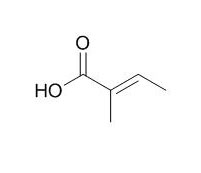Tiglic acid
Tiglic acid shows antiviral activity toward herpes simplex virus type 1.
Inquire / Order:
manager@chemfaces.com
Technical Inquiries:
service@chemfaces.com
Tel:
+86-27-84237783
Fax:
+86-27-84254680
Address:
1 Building, No. 83, CheCheng Rd., Wuhan Economic and Technological Development Zone, Wuhan, Hubei 430056, PRC
Providing storage is as stated on the product vial and the vial is kept tightly sealed, the product can be stored for up to
24 months(2-8C).
Wherever possible, you should prepare and use solutions on the same day. However, if you need to make up stock solutions in advance, we recommend that you store the solution as aliquots in tightly sealed vials at -20C. Generally, these will be useable for up to two weeks. Before use, and prior to opening the vial we recommend that you allow your product to equilibrate to room temperature for at least 1 hour.
Need more advice on solubility, usage and handling? Please email to: service@chemfaces.com
The packaging of the product may have turned upside down during transportation, resulting in the natural compounds adhering to the neck or cap of the vial. take the vial out of its packaging and gently shake to let the compounds fall to the bottom of the vial. for liquid products, centrifuge at 200-500 RPM to gather the liquid at the bottom of the vial. try to avoid loss or contamination during handling.
J Med Food.2022, 25(3):272-280.
Sci Rep.2024, 14(1):28864.
J Anal Methods Chem.2022, 2022:2229500.
J Biomol Struct Dyn.2023, 1-21.
Plants (Basel).2023, 12(22):3877.
Food Chem.2019, 276:768-775
Chem Biol Interact.2023, 378:110487.
Environ Toxicol.2019, 34(12):1354-1362
Biomedicines.2020, 8(11):486.
J Ethnopharmacol.2024, 333:118415.
Related and Featured Products
Chem Pharm Bull (Tokyo). 2014;62(8):839-44.
Calysolins X-XIII, resin glycosides from Calystegia soldanella, and their antiviral activity toward herpes simplex virus.[Pubmed:
25087638]
Four new resin glycosides having macrolactone structures (jalapins), named calysolins X (1)-XIII (4), were isolated from the leaves, stems, and roots of Calystegia soldanella ROEM. et SCHULT. (Convolvulaceae).
METHODS AND RESULTS:
Their structures were determined on the basis of spectroscopic data as well as chemical evidence. The sugar moieties of 1-4 were partially acylated by some organic acids, including Tiglic acid, 2S-methylbutyric acid, and 2S,3S-nilic acid. Additionally, the antiviral activity of 1-4 toward herpes simplex virus type 1 was evaluated.
CONCLUSIONS:
All the compounds showed antiviral activity.



